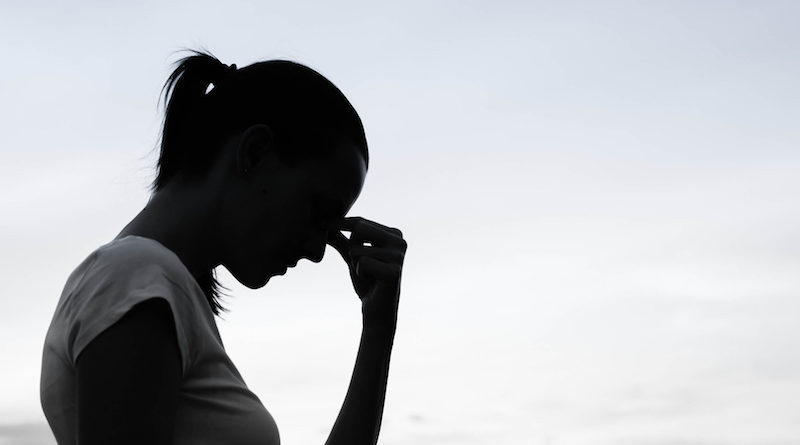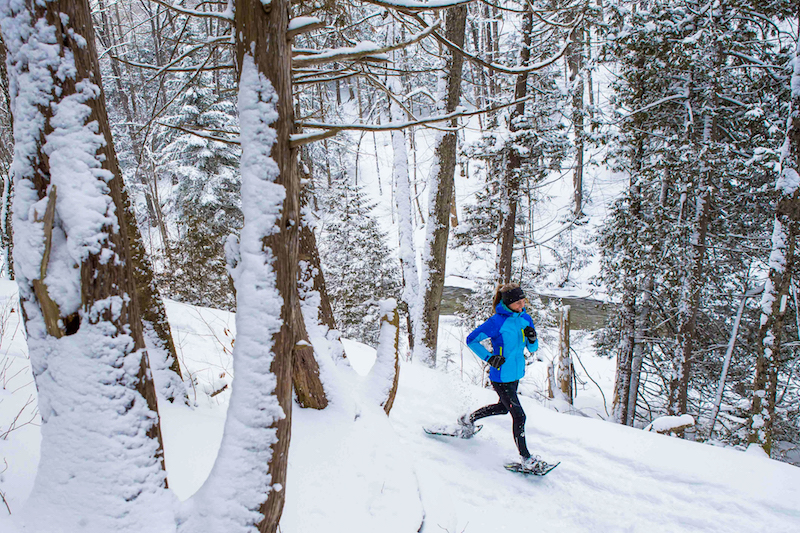Breaking SAD
One of the nation’s top experts in Seasonal Affective Disorder, UVM’s Kelly Rohan is studying how to beat the winter blues.
Every October, Corey Burdick starts an unusual morning routine. She pours her first cup of coffee, then sits down next to an Apollo goLITE—a silver square about the size of a camera that emits a bright, blue light. Basking in the glow of this artificial dawn, she tries to stave off a very severe case of the winter blues.
A few years back, during one of those particularly cold, dark winters that keeps you indoors, huddled by the woodstove, Burdick stopped feeling like herself. An avid runner—she’s run the Vermont City Marathon, the Green Mountain Marathon and a handful of halfs—she wasn’t used to feeling listless and unmotivated.
“At first I thought, maybe I just have the winter blues, because it’s dark all the time,” she says. “But I wasn’t coming out of it, and nothing seemed to be helping. I just felt so down. It was during that time that I knew something was really off.” Burdick dove into research and found an answer that made sense: Seasonal Affective Disorder.
What is SAD?
Simply put, Seasonal Affective Disorder is clinical depression that follows a seasonal pattern. As the days shorten, patients can lose interest in activities that they normally enjoy, have trouble concentrating, gain weight, sleep longer, and in the most extreme cases, have thoughts of death or suicide. Winter drains the light from the sky and takes our primary source of Vitamin D, barbecues and swimsuits with it. It subdues and sends us into a state of hibernation or worse, depression.
More than 14 million Americans suffer from the disorder, (appropriately abbreviated SAD). Prevalence ranges from less than two percent of people in southern states, like Florida, to nine percent in northern states, like Vermont.
Some treatments for SAD are similar to traditional treatments for classic, non-seasonal depression, like cognitive behavioral therapy and antidepressant medication. But there’s one very big difference: SAD patients can be treated with light.
Kelly Rohan, a leading expert in SAD and a professor at the University of Vermont’s Department of Psychological Science, says symptoms are identical to those of major depression. “It causes a lot of distress for the person, and impairment in their ability to function in important roles, like at work, in school and in relationships,” she says. “That’s where we can draw the line, I think, between people who really have SAD versus people who are around the water cooler just commiserating that they don’t like winter.”
Rohan doesn’t know what, exactly, causes SAD, but it might have something to do with biological clocks being thrown off-kilter by the changing seasons. Normally, around bedtime, the brain secretes the hormone melatonin, which signals to the brain that it’s time to sleep. In some SAD patients, that dose of melatonin arrives later than it should.
In a lab, Rohan can test whether a patient’s biological clock is running on-schedule by taking hourly samples of blood or saliva and assaying those samples to see when melatonin is produced. But this testing is cumbersome and expensive, so Rohan instead uses clues from patients’ sleeping habits to determine whether winter light is disrupting circadian rhythms.
“The patient might have a lot of difficultly rising in the morning—maybe hitting snooze over and over again, or maybe sleeping right through that alarm clock, unable to wake up,” she says. “That’s because the melatonin might still be being produced (in the morning), in theory, for somebody who’s got this kind of a pattern.”
That’s where light therapy comes in. Bright light, like that emitted from Burdick’s Apollo goLITE lightbox, suppresses melatonin. Used consistently—the normal treatment is 30 minutes each morning—the light can simulate an early dawn, readjusting the biological clock and promoting normal sleep patterns.
Sunshine and Serotonin
After Burdick was diagnosed with SAD, she tried various forms of treatment until she found a routine that worked. Now, she self-treats using a combination of light therapy, Vitamin D supplements, Omega-3 fish oils (no study backs this as a treatment for SAD, but Burdick swears by it), exercise and social activity. But one of the best treatments, she says, is sunshine.
“If I can get outside on a sunny day, I find that really helpful, especially if the sun is reflecting off the snow,” she says. “It’s hard to get motivated, but if you can force yourself to get up and out there, even for a five or ten-minute walk first thing in the morning, it really makes a big difference.”
According to Rohan, not all SAD patients show evidence of a slow-running biological clock. In those cases, the patients wouldn’t need to re-adjust their circadian rhythms, making the morning light box treatments less useful.
But light still helps, maybe because of its link to the production of serotonin, a neurotransmitter that contributes to feelings of happiness. In a study published in Psychological Medicine in March of 1998, Cambridge University scientists administered a substance that depleted the serotonin levels of SAD patients during the summertime, when they were unaffected by the disorder. Upon receiving this treatment, the symptoms returned.
Then, in a study titled, “Effect of Sunlight and Season on Serotonin Turnover in the Brain,” published by The Lancet in 2002, scientists took blood samples from 101 healthy men and determined that the longer the men were exposed to bright sunlight, the more rapidly their bodies produced serotonin. “Our findings are further evidence for the notion that changes in release of serotonin by the brain underlie mood seasonality and seasonal affective disorder,” the study concluded.
If light helps produce serotonin, and increased levels of serotonin alleviates symptoms of SAD, one might logically conclude that exposure to light helps SAD patients, even if the light exposure occurs in the middle of the afternoon. According to Rohan, gaining this exposure from natural sunlight is even better than using a light box.
“There’s more light to be had from the sky than from a light box,” Rohan says. “A light box produces 10,000 lux. On a clear, sunny day, you can get 100,000 lux outside. Of course, the snow will reflect that light, so if you’re out there doing winter sports, you can really get a lot of light.”
Rohan says that, while not every SAD patient will benefit from spending time outdoors, the sunlight and fresh air could help athletes and people who enjoy getting outside in other seasons feel much better. In an effort to practice what she preaches, Rohan jogs four miles every day.
“It has to be below zero and usually ice on the ground for me not to go,” she explains to her patients. “How do I do this? I dress appropriately. I understand in the winter I have to put on more layers. Sometimes even ski pants, and sometimes crampons. But I’m willing to do that, because I know that if I go, I’ll feel better than if I don’t go.”
Talking Power
Treatment for SAD extends beyond light treatment, whether it’s natural or on a timer on your bedside table.
In fact, in 2015, Rohan released a study showing that cognitive behavioral therapy (CBT) helps alleviate winter depression much more effectively than light therapy. Out of 177 research subjects, 46 percent of patients treated only with light therapy reported that their depression returned the following winter. Only 27 percent of those who were treated using CBT felt the symptoms again.
At its most effective, cognitive behavioral therapy extends beyond the psychologist’s office. There are two components: the “cognitive,” and the “behavioral,” and each works to pry loose the underlying thoughts and behaviors that fuel depression.
On the cognitive side, the psychologist encourages patients to identify, challenge and change negative thoughts about winter. Using the Socratic method, the psychologist asks the patient to look objectively at the depressing thoughts, then use evidence to argue them.
“For example, if we can take people from the thought, ‘I hate winter,’ to, ‘I prefer summer,’ which is more neutral in tone and doesn’t have as much effect on mood, they’re going to feel better,” Rohan says.
On the behavioral side, the psychologist asks the patient to avoid “hibernating”—that is, wrapping up in a blanket and watching TV, or allowing phone calls from friends to go unanswered. Rohan says it’s important to find activities to enjoy, whether that means braving the cold temperatures or finding indoor alternatives. But those who enjoy outdoor exercise can fight SAD from multiple angles.
“Exercise seems to have anti-depressant properties,” Rohan says. “So, if I work with someone who’s depressed, and I know that they like to exercise, I will try to capitalize on that, and make that one of the pleasant activities that they’re going to strive to do to get out of hibernation mode.”
Burdick finds that sense of community through running. “You have a support network with runners,” she says. “You have group runs. You have this community. You don’t always want to see people, but it’s actually really beneficial.”
While Burdick’s SAD used to hold her back, she now has an effective tool belt of skills she can use to curb the symptoms. She has learned how to call back her happiness during the winter—especially on sunny days when she’s running with friends.
“Those days are magical,” she says.
Dr. Kelly Rohan is currently recruiting volunteers ages 18 years old and older for a clinical trial through which diagnosis, light box treatment and cognitive behavioral therapy are offered at no charge. Interested volunteers can call 802-656-9890 or visit our website at: uvm.edu/~sadstudy.
4 Ways to Bear the Winter Blues
One of the challenges of switching seasons is embracing new sports and finding new ways to train with friends. These fun events will get you out there.
Running > Snowshoeing | Runners often think of winter as a time for cross-training and gym workouts, but with snowshoes, you can run on trails through forests all winter long. Vermont’s burgeoning snowshoe scene features a growing number of races. Try the Susan G. Komen Snowshoe for a Cure at Stratton on Jan. 6 or the PEAK Snow Devil Snowshoe Race in Pittsfield on Feb. 17. If you’re looking to test yourself, try the 100-mile Winter Ultra, also in Pittsfield on Feb. 17.
Running / Cycling > Nordic Skiing | Nordic skiing (particularly skate skiing) helps maintain both the cardio fitness and the strength that’s built up all summer. But jumping into these sports can be daunting. f you’re a runner, sign up for Craftsbury Outdoor Center’s Skiing for Runners Camp, Jan. 24-27. Start with fun events, like the Stowe Derby, a race from the top of the Mt. Mansfield Toll Road all the way to town. Costumes welcome. Note a new date this year of Jan. 13.
Mountain Biking > Fatbiking | Many of Vermont’s best mountain bike networks now groom for fatbikes and many cross-country ski centers own a rental fleet. Rikert Nordic Center’s Fatbike Round-Up is a day of rides, cookouts, and camaraderie on Dec. 22. Check out for Uberwintern, a fatbike festival in Stowe, Jan. 5 or head to Kingdom Trails for Winterbike, March 1-2.
Rock Climbing > Ice Climbing | As you might guess, these translate pretty well, and that’s not all: Ice climbing has one of the best parties of the winter, Smuggs Ice Bash, Jan. 25-27, which includes clinics for beginners, presentations, dinners and an (indoor) kick-off party.


